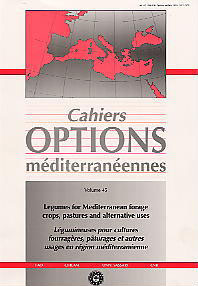| Article précédent | p. 299-303 | Article suivant |
Grazing effects on a perennial legume, Bituminaria bituminosa (L.) Stirton, in a Mediterranean rangeland
Bituminaria bituminosa (L.) Stirton is an hemicryptophyte Mediterranean legume characterized by secondary compounds in its mature leaves and by resistance to heavy grazing. Its growing season extends from before the onset of the rains to the end of the spring, attaining primary production double to that of the common herbaceous species. In winter and early spring, when more palatable species are available to the cattle, it is grazed only under heavy stocking rates. Cattle start grazing it under moderate grazing pressures only in mid-spring, when the principal grasses become less palatable. In late spring, when the herbaceous species dry up, B. bituminosa becomes the only species with green leaves and cattle graze the whole plant intensively. B. bituminosa response to grazing was studied in a long-term grazing experiment in a Mediterranean herbaceous community from 1974 to 1990. Results showed that B. bituminosa cover significantly increased with intensity of grazing in both deferment and continuous grazing regimes.
- [ Afficher ]
- [ Télécharger ]
- [ Exporter la citation ]
Vous pouvez télécharger la citation au format :
- [ Imprimer ]
-
Mots-clés
BOVIN, PATURAGE, PATURAGES, TAUX DE CHARGECiter cet article
Gutman M., Perevolotsky A., Sternberg M. Grazing effects on a perennial legume, Bituminaria bituminosa (L.) Stirton, in a Mediterranean rangeland. In : Sulas L. (ed.). Legumes for Mediterranean forage crops, pastures and alternative uses . Zaragoza : CIHEAM, 2000. p. 299-303. (Cahiers Options Méditerranéennes; n. 45). 10. Meeting of the Mediterranean Sub-Network of the FAO-CIHEAM Inter-Regional Cooperative Research and Development Network on Pastures and Fodder Crops, 2000/04/04-09, Sassari (Italy). http://om.ciheam.org/om/pdf/c45/00600215.pdf



